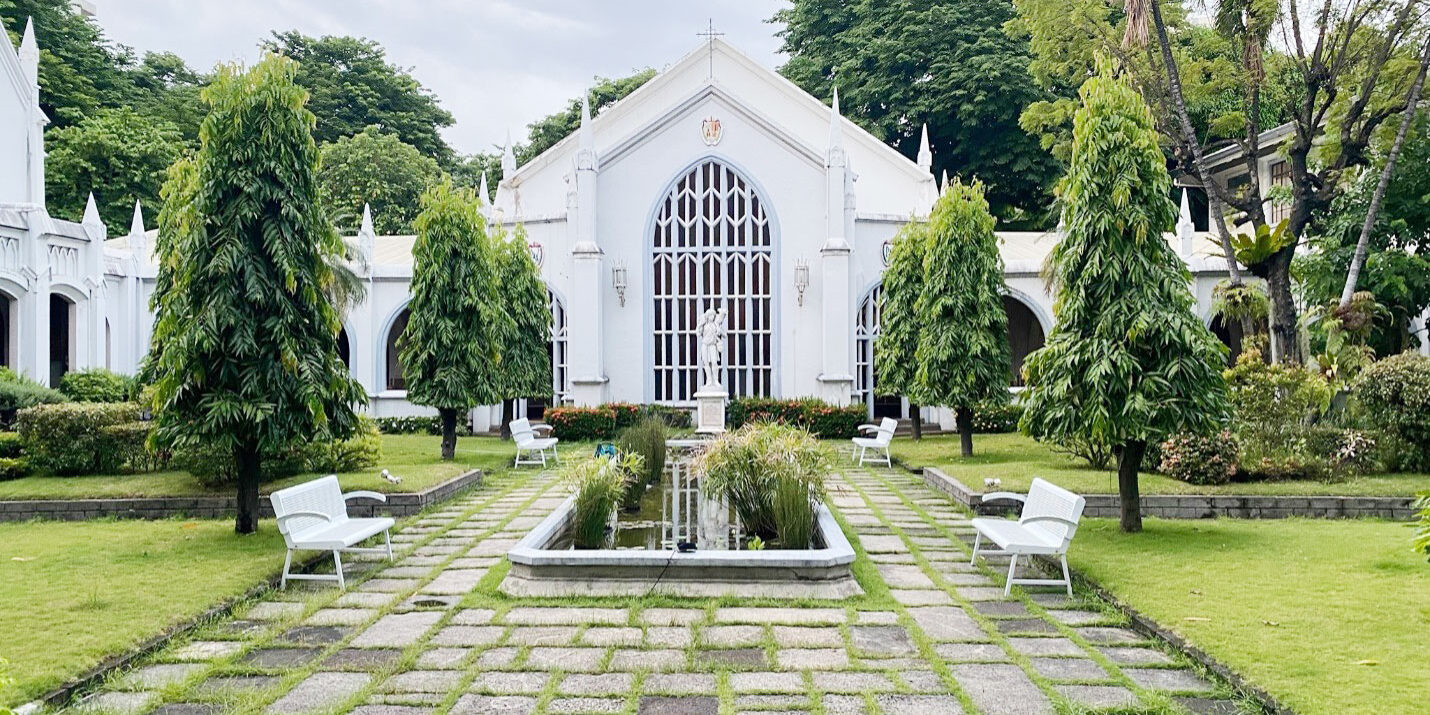A quarter century after the Mendiola campus opened, Abbot Celestine Gusi presided over the second construction wave and artistic flowering in San Beda. St. Benedict’s Hall was constructed and inaugurated in 1952. Covered basketball courts followed a year later. At St. Bede’s Hall, the Jubilee garden and fountain were built and an obelisk honoring the Bedan dead was erected. The Sabater garden and fountain was built at another wing. Five years after Abbot Gusi returned to Europe to take on the higher post of Abbot Visitator, another structure, St. Anselm’s Hall, was inaugurated, in 1963.
At the Abbey itself, the Roman garden with a rectangular center pond was created, an Abbey extension was built, a new ornate tabernacle was acquired, the tower housing the abbot’s room was constructed. The church was enlarged, and side aisles were built. A pipe organ was installed, and a marble altar of St. Bede was provided. A statue of The Good Shepherd was put in place in the landscaped garden.
The Filipino Benedictines
Abbot Gusi’s legacy is manifested not just through the physical improvements but is more importantly rooted in the fateful decision to Filipinize the abbey. The practice of bringing in monks from Spain was discontinued. The responsibility for recruiting Filipinos to receive the torch was first handed to Fr. Anselmo Sison, one of the first Filipino Benedictines. Among the early novices who survived the rigors of Benedictine formation were Fr. Celestine Say, who became the first Filipino prior, and Fr. Benito Afuang, who became the first Filipino principal.
The precarious dearth in vocations started two decades earlier. No novice had entered the cloister since the financially disastrous 1930’s. When Abbot Gusi’s group arrived in 1948, there were only eight Spanish priests left. The ranks were so depleted that Fr. Sergio Martinez held multiple posts – rector, high school principal, athletic moderator, etc.
Fr. Sylvestre Lacson, a prior and rector, referred to Abbot Gusi’s decision to recruit Filipinos as “a watershed in Benedictine evolution”. Those who passed the litmus test and withstood the vocation fallout in the years following the reforms promulgated by the Second Vatican Council guided the school’s progress through the turbulent political unrest of the 1960’s. Protest rallies were frequently held in front of San Beda’s gates.
The construction of a new water sports complex- training pool, diving pool, and pool bleachers, was started in in this period with assistance from the alumni and parents, and formally inaugurated on 2 February 1968.
A new Alma Mater Hymn was sung by the Class of 1969 during their graduation. The lyrics were written by Raul Roco, senator, with music by Fr. Benildus Maramba.
This was the period when Ninoy Aquino, Class of 1948, captured the nation’s imagination and was projected as the next national leader in elections set for 1973.
Batas Militar at Diktadura
But Martial Law was imposed in 1972 and Ninoy Aquino, Ramon Mitra, Raul Roco, Rene Sauisag, and other Bedan leaders were arrested.
Under the dark years of the dictatorship, Rectors Fr. Bernardo Perez, Fr. Emmanuel Balcruz, and Fr. Sylvestre Lacson ably kept the school on even keel in the face of constant monitoring, pressure, and threats by government agencies. Priests criticized the dictatorship through homilies. Students and alumni attacked the dictator through protest rallies that occasionally involved cocktails with a Russian name. A number joined the underground resistance in the fight for freedom and basic rights; many were arrested. Among them was a Benedictine monk, Carlos Tayag, who was never able to return to the cloister.
The office of the The Bedan, the school paper, doubled as secret headquarters for the leaders of student activism. On the spiritual side, the Peace Retreat Movement started. Leading the program were Fr. Bellarmine Baltasar, who would become rector of Alabang, and Fr. Andres Formilleza, who would become abbot in 1989.
Benedictine Abbey School in Alabang opened in 1972, offering Grade School and High School. It is now named San Beda College Alabang, offering education up to graduate level. In 1981, the Monastery of the Transfiguration was founded in Malaybalay, Bukidon with Abbot Eduardo Africa as superior.
On 21 August 1983, Bedan Ninoy Aquino was assassinated, and the country was plunged in turmoil. Bedans participated in all sorts of protest actions attacking the violent abuse of power and the plunder of the country’s coffers. Ninoy’s hearse passed streets lined by two million people in a stinging rebuke to the dictator.
To honor Aquino, The Bedan published a special issue. A Holy Mass, with the widow and future president Corazon Aquino in attendance, was celebrated in the abbey church by Fr. Sylvestre Lacson, Ninoy’s high school classmate. The protests culminated in the 1986 People Power Revolution.
The first St. Placid’s Hall, which housed the medical-dental clinic and the bookstore, was completed on 1976. The athletics/scouting building was blessed in 1982. An extension was built on St. Anselm’s Hall, above the existing grandstand, also in 1982.
(Source: https://www.sanbeda.edu.ph/post/76/history-of-san-beda)





